Transplanting Mussel Seed with the Disc-Net-Line System
Since the development of our idea for the "Mussel Disc", we have come up with a very efficient way of incorporating the it into a new system of reseeding mussels; an eco-friendly, re-usable system we call the "Disc-Net-Line System", which may be used for individual mussel socks for raft culture or for continuous socks as used in long line culture.
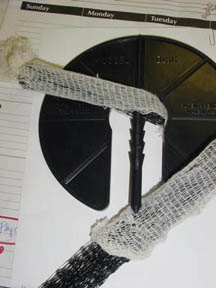
Our Disc-Net-Line System incorporates some of the best ideas we have learned through trial and error, and by observing what works well in other areas.
Shown here are the basic components of the Disc-Net-Line System which we have developed. The core "rope" or "Net-Line" is actually a re-usable extruded plastic material on which the mussels grow very well due to the large amount of surface area and attachment points for the mussel byssus threads. This material also allows for easy and firm placement of the Mussel Discs.
The purpose of the cotton sleeve is similar to that used in New Zealand and in Nova Scotia, as it holds the seed mussels onto the line until they are firmly attached.
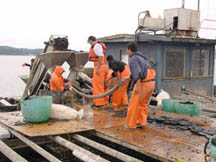
Our seeding machines mechanically feed the seed into the cotton sleeves while surrounding the Net-Line at the density established by the machine operator. The new mussel sock or "Disc-Net-Line" (DNL), can be made as individual socks or as continuous 1000 meter socks. The rate of socking is approximately one meter per second.
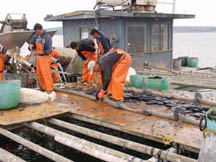
Depending upon whether the farmer uses individual mussel socks for raft culture (as shown here), or continuous socking for long line culture, the Mussel Discs may be easily inserted after the sock is completely filled or continuously as the sock is being made.
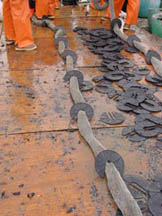
Once the new sock or "DNL" (shown on the right), is complete, it may be suspended from the raft or long line into the water immediately, requiring no time at all for the byssal threads to attach.
Once in the water, it takes approximately three weeks for the cotton sleeve to rot away entirely; during this time, the mussels have become firmly attached to the Net-Line and begin to grow. Mussels do not need to fight their way out of the mesh as with traditional type mussel socking, thus allowing the mussels to grow much faster than when using other types of sock.
The following pictures illustrate a new Disc-Net-Line as the cotton rots away during a three week period, and finally how the mussels adhere to the line and rest on the Mussel Discs.
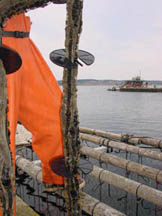 |
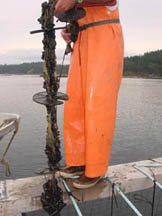 |
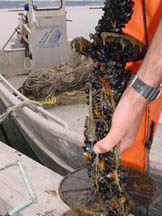 |
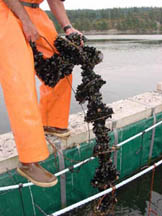 |
Benefits of the Disc-Net-Line system are:
- The components of the DNL system may be used year after year, with only the cotton requiring replacement.
- The mussels attach firmly to the outside of the "Net-Line" and will never be caught inside a mussel sock.
- There is no used socking to take to the landfill after harvest, therefore providing a savings on solid waste fees.
- One is not required to inventory several different sizes of mussel socking depending upon the size of the mussel seed.
- This method may be used with raft or long line systems and is extremely fast.
